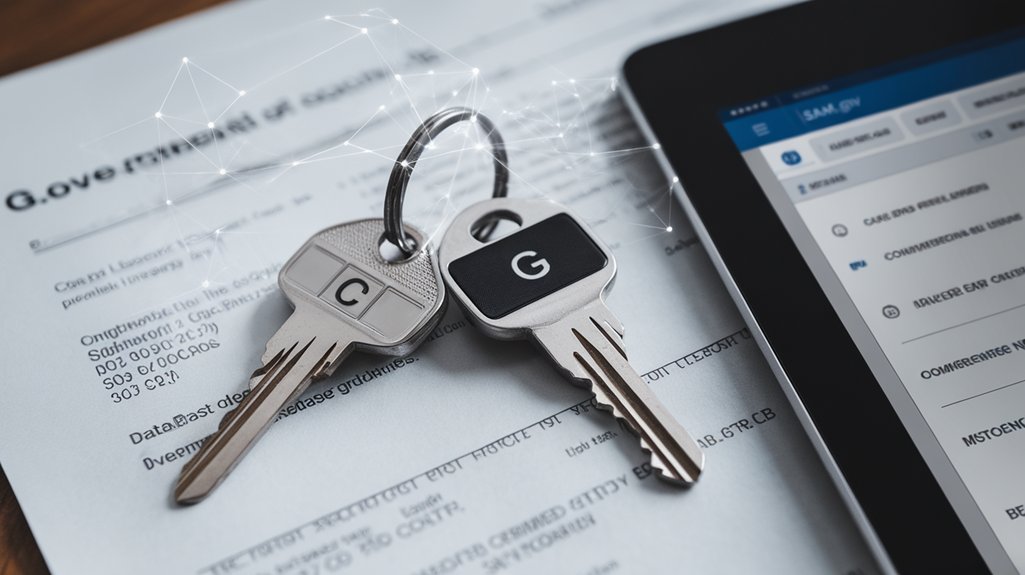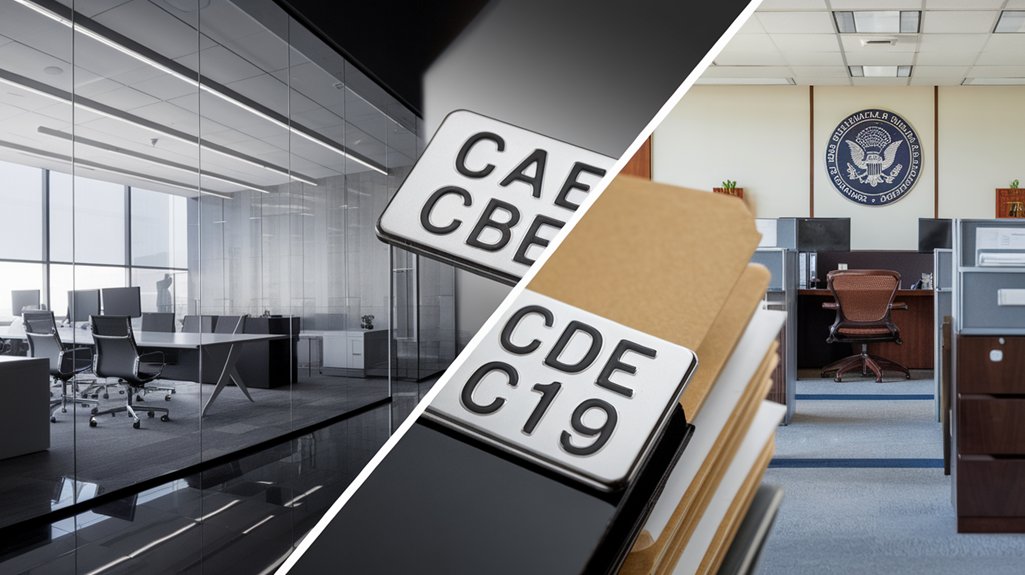Contrary to common belief, no difference exists between commercial and government CAGE codes in the SAM registration process. All entities—whether federal agencies, nonprofits, or businesses—follow identical protocols through SAM.gov to receive their five-character alphanumeric identifier. The Defense Logistics Agency applies uniform standards across sectors, assigning codes based on physical location verification rather than entity type. Understanding this uniformity helps organizations navigate federal contracting requirements more effectively.
Breaking the Myth: Why CAGE Codes Don’t Differentiate Between Commercial and Government Entities

Despite widespread assumptions in government contracting circles, CAGE codes do not actually distinguish between commercial businesses and government entities. This represents one of the most common CAGE code misconceptions in the federal procurement space.
CAGE codes treat commercial businesses and government entities identically, contrary to popular misconceptions in federal contracting.
The five-character identifier serves as a universal tracking mechanism for any organization that engages with federal contracts, regardless of their classification. Government contractor myths often suggest special prefixes or formats exist for government-affiliated organizations, but the Defense Logistics Agency applies identical standards across all sectors. The CAGE code system provides unified search solutions for identifying suppliers across all government and defense agencies.
When entities register in SAM, the system automatically initiates CAGE assignment based on physical location verification, not entity type. Federal agencies, nonprofits, educational institutions, and commercial businesses all receive codes following the same protocol. The CAGE code is automatically assigned post-registration and entities will receive notification via email upon successful processing. Organizations seeking government contracts must complete the SAM registration before they can be assigned a CAGE Code by the DLA.
This standardization enables consistent supplier tracking across procurement tiers and guarantees compliance with FAR 52.204-16, which mandates active CAGE codes for all federal contractors without exception.
Single Standard: How CAGE Codes Apply Uniformly Across All Federal Contractors

Uniformity defines the CAGE code system across the federal contracting landscape, creating a single identification standard for all entities engaged in government procurement.
The five-character alphanumeric CAGE code structure applies equally to commercial businesses, nonprofit organizations, and government agencies, eliminating the need for separate tracking systems based on entity type.
This federal procurement standardization, mandated since 2014, guarantees consistent tracking of hardware, software, and data across the entire supply chain. Whether an organization is a large defense contractor, small business, or academic institution, the same requirements apply for obtaining and maintaining a CAGE code through SAM.gov registration. The registration process is essential for organizations seeking eligibility for federal contracts and grants.
The system assigns codes based on physical location rather than organizational classification, enabling effective supply chain mapping. Large companies may have multiple CAGE codes for different operations or business departments, which helps the DoD identify specific organizational components in contracts. While domestic contractors receive standard CAGE codes, international entities must obtain NCAGE codes through their respective NATO channels before completing CCR registration. This approach simplifies contract management while strengthening security and compliance frameworks across diverse contractor populations operating in the defense acquisition environment.
Navigating SAM Registration: The Universal CAGE Code Process for All Organizations

While organizations of all types initiate their federal contracting journey through SAM.gov, the CAGE code assignment process follows identical steps regardless of entity size or classification.
The universal CAGE code registration procedure guarantees standardization across government procurement systems, creating a level playing field for all potential contractors.
The SAM registration process includes these essential steps:
- Create an account on SAM.gov and gather required documentation including legal business name, physical address, and TIN
- Complete the online registration form with accurate entity information and banking details
- Submit the registration for processing, which typically takes several business days
- Receive automatic CAGE code assignment upon successful validation of entity information
This standardized approach streamlines contractor identification and verification across federal agencies.
Organizations should note that no pre-existing CAGE code is required to begin registration, as the system automatically assigns this unique identifier once all validation requirements are met.
The CAGE code serves as a unique alphanumeric identifier that distinguishes organizations in the government database system.
A CAGE code is essential for businesses seeking to access federal contracts and become eligible for government procurement opportunities.
Applicants should prepare for potential delays in processing as validation procedures may require additional verification steps depending on the complexity of the entity information provided.
Frequently Asked Questions
Can a Single Entity Have Multiple CAGE Codes?
Yes, a single entity can have multiple CAGE codes, typically when it operates different business units or locations.
CAGE code consolidation may be necessary when merging operations or streamlining procurement processes.
When a company acquires another business, CAGE code transfer procedures must be followed to properly maintain government contract eligibility.
Organizations should regularly review their CAGE code portfolio to guarantee accurate representation of their operational structure in the Defense Logistics Agency’s system.
What Happens to My CAGE Code if My Business Relocates?
When a business relocates, the company must update its physical address in the SAM system. This business address update is essential for maintaining an accurate CAGE code registration.
The process involves:
- Logging into the SAM.gov account
- Updating the company’s physical location information
- Submitting for validation
The update typically takes about 10 business days to process.
Companies with multiple locations may require separate CAGE codes for each operational facility.
How Do International Joint Ventures Manage CAGE Code Requirements?
International joint ventures face unique compliance challenges when managing CAGE code requirements.
For U.S.-based operations, the venture obtains a standard CAGE code, while international operations require NCAGE codes through the NATO Codification Tool.
Joint ventures must register in SAM, maintain clear documentation of ownership structures, and guarantee all partners understand their regulatory obligations.
Regular monitoring of CAGE/NCAGE status is essential, particularly when changes occur in the venture’s structure, location, or ownership.
Are CAGE Codes Publicly Searchable Outside of SAM.Gov?
CAGE code visibility outside SAM.gov is limited.
While these codes themselves are not thoroughly searchable in a single public access database, some information may appear in specialized government databases or third-party services.
The Defense Logistics Agency maintains a master file, but public access is restricted.
Entities seeking complete CAGE code information typically need SAM.gov registration, as most publicly available lists only include registered vendors or contractors with active government relationships.
Can Subcontractors Operate Without Their Own CAGE Codes?
Subcontractors can operate without CAGE codes if they don’t require access to classified information.
The subcontractor requirements vary based on the nature of work performed. For contracts involving classified materials, CAGE code necessity becomes mandatory for security compliance.
However, subcontractors working on non-classified government projects may function without a CAGE code, though this might limit their participation in certain contracts.
For maximum opportunity access, obtaining a CAGE code through SAM.gov registration is recommended.